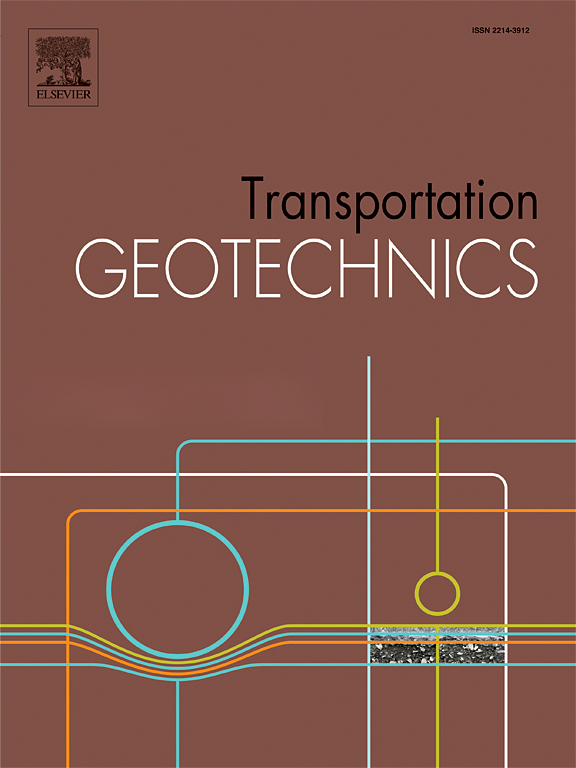Numerical studies of ballastless track-embankment vibrations considering track irregularities
IF 4.9
2区 工程技术
Q1 ENGINEERING, CIVIL
引用次数: 0
Abstract
High-speed railway systems require precise modelling of track-embankment dynamics to assess structural stability and safety. Existing models struggle to capture the complex nonlinear interactions between trains and track infrastructure. To overcome this limitation, a three-dimensional finite element (3D FE) model was developed to simulate the dynamic responses of track-embankment coupling systems based on the Wuhan-Guangzhou high-speed railway, and it was validated with field measurements. The proposed model innovatively incorporates the geometric complexities of railhead and wheel tread surfaces, along with multiple track irregularities, ensuring realistic simulations. An empirical filtering rule was introduced to address high-frequency numerical noise, enhancing data processing accuracy. The validated model was used to investigate the effects of train speed and track irregularities on the vertical and lateral vibrations of railway system. Results show that vibration intensity rises as train speed increases, with vertical rail vibrations being 1.9 to 2.9 times stronger than lateral vibrations. Moreover, track irregularities amplify embankment vibrations, particularly at higher frequencies and shallower depths, while soil damping mitigates this effect at greater depths. These findings provide valuable insights into the dynamic behaviour of ballastless track-embankment systems and contribute to the development of design and maintenance strategies for high-speed railway infrastructure.
考虑轨道不规则性的无砟轨道-路堤振动数值研究
高速铁路系统需要精确的轨道-路堤动力学模型来评估结构的稳定性和安全性。现有的模型难以捕捉列车和轨道基础设施之间复杂的非线性相互作用。为了克服这一局限性,建立了基于武广高速铁路轨道-路堤耦合系统的三维有限元模型,并进行了现场实测验证。提出的模型创新地结合了轨道头和车轮踏面的几何复杂性,以及多种轨道不规则性,确保了仿真的真实性。引入经验滤波规则来处理高频数值噪声,提高数据处理精度。利用该模型研究了列车速度和轨道不平整度对铁路系统纵向和横向振动的影响。结果表明:振动强度随列车速度的增加而增大,钢轨纵向振动强度是横向振动强度的1.9 ~ 2.9倍;此外,轨道不平整会放大路堤的振动,特别是在较高频率和较浅深度时,而土壤阻尼会在较深的深度处减轻这种影响。这些发现为无砟轨道-路堤系统的动力特性提供了有价值的见解,并有助于高速铁路基础设施设计和维护策略的发展。
本文章由计算机程序翻译,如有差异,请以英文原文为准。
求助全文
约1分钟内获得全文
求助全文
来源期刊

Transportation Geotechnics
Social Sciences-Transportation
CiteScore
8.10
自引率
11.30%
发文量
194
审稿时长
51 days
期刊介绍:
Transportation Geotechnics is a journal dedicated to publishing high-quality, theoretical, and applied papers that cover all facets of geotechnics for transportation infrastructure such as roads, highways, railways, underground railways, airfields, and waterways. The journal places a special emphasis on case studies that present original work relevant to the sustainable construction of transportation infrastructure. The scope of topics it addresses includes the geotechnical properties of geomaterials for sustainable and rational design and construction, the behavior of compacted and stabilized geomaterials, the use of geosynthetics and reinforcement in constructed layers and interlayers, ground improvement and slope stability for transportation infrastructures, compaction technology and management, maintenance technology, the impact of climate, embankments for highways and high-speed trains, transition zones, dredging, underwater geotechnics for infrastructure purposes, and the modeling of multi-layered structures and supporting ground under dynamic and repeated loads.
 求助内容:
求助内容: 应助结果提醒方式:
应助结果提醒方式:


